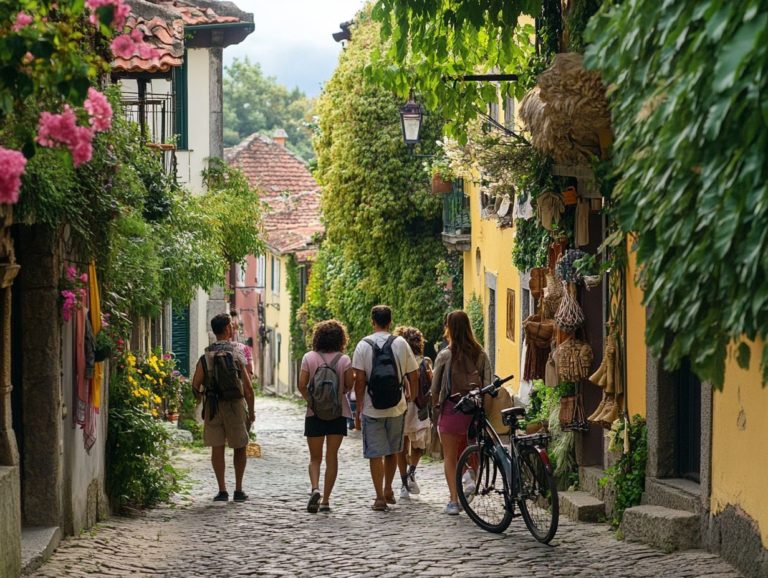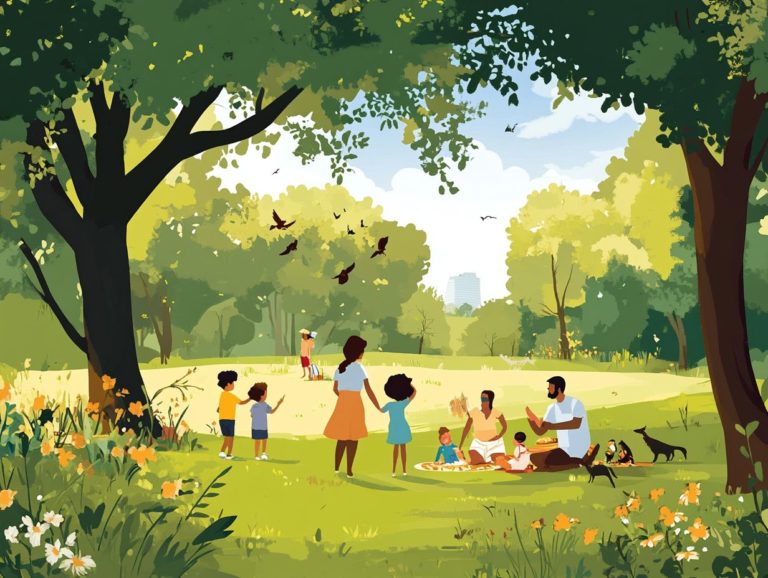Discovering Local Flora: Eco-Conscious Botany
In a world that is becoming increasingly conscious of its ecological footprint, native plants offer numerous benefits that go beyond aesthetics.
By enhancing local biodiversity and providing sustainable resources, prioritizing native flora can significantly transform your environment and community.
This exploration delves into the vital role of native plants, providing practical strategies for identifying and appreciating them, as well as ethical practices for engaging with the natural world.
Embrace this opportunity to enrich your daily life while cultivating a deeper connection to the vibrant ecosystems that surround you.
Contents
Key Takeaways:

- Discover the importance of local flora and why it is crucial to focus on native plants for a sustainable environment.
- Explore the benefits of eco-conscious botany, including its positive impact on the environment and personal/community well-being.
- Learn how to identify local flora and practice ethical harvesting and preservation techniques while incorporating native plants into daily life.
The Importance of Local Flora
Local flora plays a crucial role in maintaining ecological balance, particularly as rapid urbanization encroaches on native habitats and increases habitat loss.
Understanding the significance of native plants in your landscapes allows you to enhance conservation efforts that aim to preserve biodiversity and support the local ecosystem.
This understanding is key not just for wildlife but for ensuring the sustainability of your outdoor adventures, from birdwatching to exploring nature trails.
Why Focus on Native Plants?
Focusing on native plants is essential for creating vibrant wildlife habitats, as they are naturally suited to local environmental conditions and require less maintenance than invasive species.
These plants are crucial for supporting local wildlife, providing food sources and shelter for various creatures, including pollinators like bees and butterflies, as well as birds and small mammals.
The deep root systems of native plants enhance soil health by preventing erosion and improving water retention, fostering a more resilient ecosystem.
Experts like Doug Tallamy emphasize the importance of these plants in enhancing biodiversity, asserting that landscapes filled with native flora play a vital role in maintaining ecological balance.
By choosing to cultivate native species, you can make a meaningful contribution to preserving local ecosystems while enjoying the added benefit of reduced upkeep.
Benefits of Eco-Conscious Botany
Embracing eco-conscious botany not only enhances your landscapes but also plays a crucial role in promoting sustainability and minimizing your environmental impact on climate change.
Making these thoughtful choices contributes to a healthier planet for generations to come.
Environmental Impact and Sustainability

Your landscaping choices are significant in the battle against climate change, either amplifying its effects or helping to alleviate them. It s essential to prioritize biodiversity and water conservation in your gardening practices, especially in areas near rivers and streams and in desert ecosystems.
By adopting sustainable gardening techniques, you can cultivate healthier ecosystems that support diverse plant and animal species while enhancing resilience to climate fluctuations.
For instance, incorporating native plants into your landscape creates habitats that are better suited to local weather patterns. Practices like rainwater harvesting enable you to optimize precious water resources, reducing reliance on municipal supplies.
These methods not only improve soil health but also minimize runoff, benefiting local flora and fauna while promoting carbon dioxide absorption.
Ultimately, the mindful choices you make in your garden can create a ripple effect, positively contributing to climate change mitigation efforts and fostering a richer, more biodiverse environment.
Start implementing these practices in your own garden today and make a difference for our planet!
Personal and Community Benefits
The personal benefits of integrating native plants into your landscapes can be truly transformative. They elevate environmental awareness and inspire participation in conservation efforts.
These efforts also protect native wildlife and their habitats. By embracing native landscaping, you cultivate stunning environments and forge deeper connections with nature and each other.
These spaces enhance your outdoor experiences, allowing you to immerse yourself in local flora and fauna right in your own backyard.
When neighbors collaborate on community gardening projects or organize workshops on native plant species, including those that support monarch butterfly populations, they strengthen their bonds and share invaluable knowledge.
Discover the amazing success stories of local conservation initiatives, like native plant sales or educational programs at community centers. These examples show how collective efforts to promote indigenous flora enrich ecosystems and deepen appreciation for nature s vital role in our lives, especially in California along the Colorado River.
Identifying Local Flora
Identifying local flora is an enriching experience and an essential skill. It deepens your understanding of our environment and enhances your appreciation for the diverse plant species in our ecological reserves, including riparian habitats and desert ecosystems.
Tools and Techniques for Plant Identification
Utilizing various tools and techniques for plant identification can significantly enhance your gardening experience and your connection with nature. This knowledge empowers you to recognize native flora and make informed landscaping choices.
For instance, apps like PlantSnap or botanical field guides are invaluable resources that allow you to quickly identify species with a simple photo. Audubon s database further enriches your understanding, providing detailed insights into plant characteristics that improve your identification accuracy. A smart strategy is to familiarize yourself with key traits like leaf shape and flower color to streamline the identification process.
Cultivating a passion for nature photography captures the beauty of local flora and serves as a visual reference for future identification. This creates a meaningful archive that documents the vibrant landscape around you, especially when it features native wildlife such as hummingbirds and bighorn sheep.
Ethical Practices in Botanical Exploration

Engaging in ethical practices during your botanical explorations is essential for preserving native ecosystems and biodiversity. By doing so, you actively support conservation efforts that protect our natural world.
Your commitment to these principles fosters a deeper connection with nature and contributes to the health of the environment for future generations.
Responsible Harvesting and Preservation
Responsible harvesting of native plants is crucial for ensuring that these vital species remain abundant and sustainable. This practice supports ecological balance and contributes to local conservation initiatives and enhances wildlife habitats.
To engage in responsible harvesting, understand the life cycles of these plants and collect only what is necessary, minimizing disruption to their populations. Follow these guidelines:
- Selecting healthy specimens
- Avoiding overharvesting
- Keeping their homes healthy
By following these principles, you safeguard the health of native flora and help preserve the intricate relationships they share with local wildlife.
By cultivating responsible harvesting habits, you can play a significant role in preserving biodiversity and enhancing the resilience of ecosystems against various environmental pressures like climate change.
Incorporating Local Flora into Daily Life
Incorporating local flora into your daily life is more than just looking good; it represents a commitment to sustainable practices that enrich your outdoor experience while nurturing the health of local ecosystems. This can be achieved through thoughtful landscaping choices and eco-friendly practices.
Ideas for Using and Appreciating Native Plants
You ll discover countless ways to embrace and appreciate native plants in your daily life. Whether you’re embarking on outdoor adventures, exploring nature, or enhancing your birdwatching experience with thoughtfully chosen flora, the possibilities are endless.
Creating a bird-friendly garden is a great way to invite the wonders of wildlife into your backyard. Picture vibrant coneflowers and sweet-smelling bee balm filling your garden with life, providing sweet nectar for hummingbirds and butterflies nature s own little treasures that support local bird populations.
Establishing community gardens that focus on indigenous species nurtures caring for the environment while strengthening communal bonds. These gardens serve as hubs for nature exploration and wildlife spotting.
For the adventurous spirit, nature trails adorned with native greenery can elevate your hiking experience. They offer visual splendor and serve as habitats for local wildlife, including desert wildlife like the desert tortoise and kit foxes.
As a birdwatching enthusiast, you can amplify your experience by researching which plants attract specific local species, like the Yellow-billed Cuckoo or Western Meadowlark. Pairing these plants with well-placed feeders will help you cultivate a lively and diverse ecosystem right in your neighborhood.
Frequently Asked Questions

What is eco-conscious botany?
Eco-conscious botany is the practice of studying and interacting with local flora in an environmentally responsible way. It involves understanding how plants contribute to their ecosystems and promoting sustainable practices to protect and preserve their habitats.
How can I get started with discovering local flora?
The best way to get started is to do some research and find local resources. Look for botanical gardens, nature centers, and field guides. These resources can provide you with information on where to go and what to look for when exploring your local flora.
Why is it important to discover local flora?
Discovering local flora is crucial because it allows us to understand the diversity and complexity of plant life in our communities. It helps us appreciate the interconnectedness of all living things and the importance of preserving natural habitats.
How can I be eco-conscious while exploring local flora?
There are several ways to be eco-conscious while exploring local flora: stay on designated trails to avoid damaging plants and their habitats, avoid using pesticides and herbicides, and properly dispose of any waste or garbage.
What are some benefits of eco-conscious botany?
Eco-conscious botany can have numerous benefits, including promoting environmental awareness, providing opportunities for outdoor recreation and education, and contributing to scientific research and conservation efforts.
Can I discover local flora in urban areas?
Yes, you can! While it may be more challenging to find natural areas in urban environments, there are often community gardens, parks, and green spaces that support local flora. You can also look for native plants in your own backyard or on neighborhood walks.
Start your journey with local flora today; you’ll be amazed at what you discover!






